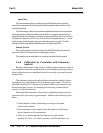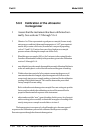
1-40 Part III
Part III Model 6600
Teledyne Analytical Instruments
Fill the sample cell with air or a stable fluid, such that the photo energy
which strikes the detector is constant. A stable fluid is distilled or tap water, clean
ocean water or filtered and sparged sample. This step may be omitted when the
system is stable in its present state.
Open the detector module for scope probe access to test points in explosion
proof systems. Always keep stray light out by covering the opening with a dense
black cloth. If this precaution is not taken, misinterpretation of the scope pattern
results.
The scope test points on general purpose systems are located in the bottom
of the detector module and accessible without opening the module.
7.2 Set Up of the I to E Converter
The I to E Converter converts the small current pulses, produced by the
phototube to a voltage, the output of this amplifier goes to the input of the second
amplifier which output magnitude can be adjusted by means of a gain control
R2. Its location is on PC Board 1 inside the detector module and on E.P.
Analyzers.
The output of the I to E Converter can be observed, by connecting the
ground lead of the scope to TS11-5 and the scope probe to TS2-1 for explosion-
proof systems and TS5-1 and TS5-2 for general purpose systems.
The oscilloscope displays the measuring and reference pulses in an
alternating pattern.
The display is created by the light passing through the reference and
measuring filters as they are brought in and out of the light beam by the rotating
filter wheel. The baseline represents the blocking of the light beam by the
opaque part of the filter wheel.
To identify which of the pulses is the measuring peak, insert a piece of flat
glass or Plexiglas and the peak that becomes the shortest (retracts excessively)
is the measuring filter pulse.
In case the gain cannot be properly set due to either too short, too tall or too
much out of balance peaks, refer to Section 1.5. Adjust R2 trimpot on PC1 until
the desired peak height is obtained as observed on the scope, usually 7 to 8 volt,
for the tallest of the two peaks. Never leave the system operating with peaks
exceeding 10 volts or the logarithmic amplifier may saturate. No oscillations or
distortions are permitted on the peaks.


















